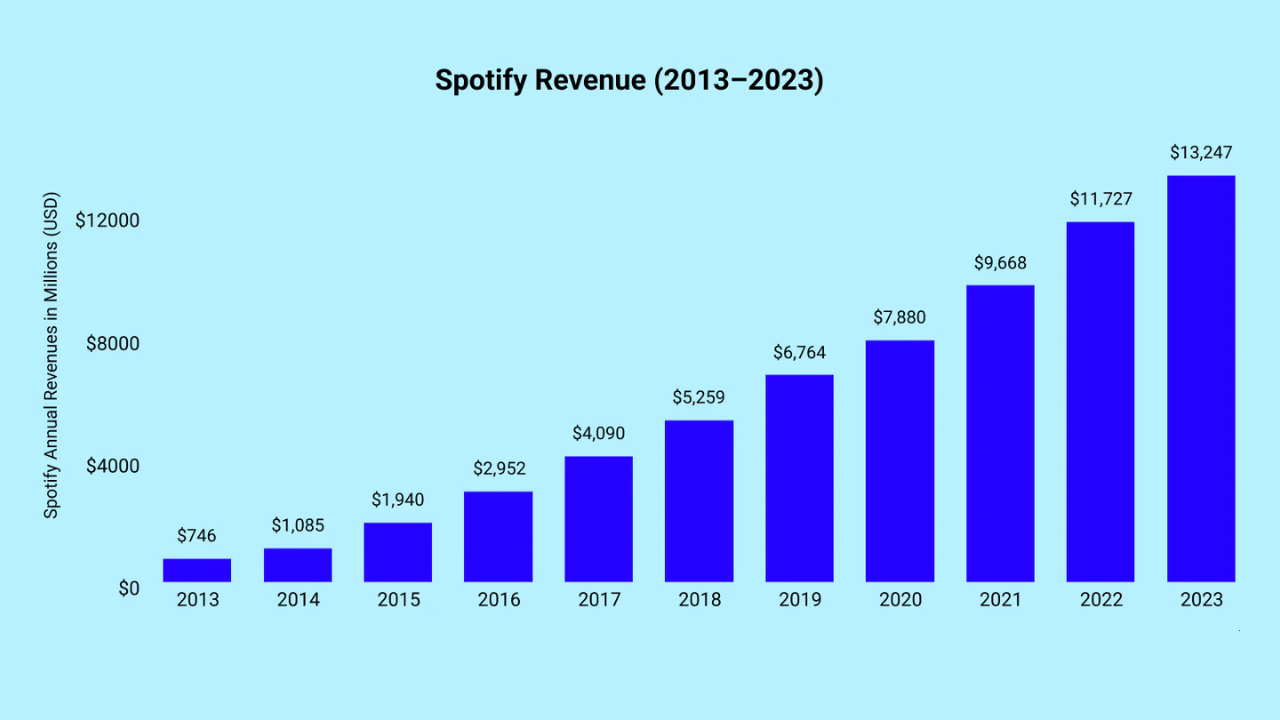Spotify, the world’s leading music streaming platform, has redefined how we consume music. From humble beginnings in 2006 to becoming a global phenomenon, Spotify’s revenue growth reflects its transformative role in the music industry. With a mix of subscriptions, advertising, and innovative business models, Spotify’s revenue strategies are worth exploring.
This article dives deep into how Spotify revenue is generated, its financial milestones, and the challenges it faces in an ever-evolving market.
The Core of Spotify’s Revenue Model
Spotify earns its revenue primarily through two key streams:
- Premium Subscriptions: Monthly payments by users for an ad-free and feature-rich experience.
- Advertising: Ad-supported free-tier users generate revenue through targeted ads.
Spotify Premium offers several benefits, including offline downloads, ad-free listening, and higher audio quality. Subscriptions are available in multiple plans:
- Individual Plan: A single-user subscription.
- Family Plan: Up to six accounts.
- Student Plan: Discounted pricing for students.
- Duo Plan: For two users in the same household.
How Subscriptions Impact Spotify Revenue
With over half of Spotify’s revenue coming from Premium users, subscription plans are vital. In 2021, Premium subscribers accounted for nearly 90% of total revenue, showcasing the importance of this model.
2. Ad-Supported Free Tier
Spotify’s free-tier users experience ads between songs. Advertisers pay Spotify to reach millions of users daily. This model generates significant revenue by leveraging its vast user base.
Types of Ads on Spotify:
- Audio Ads: Heard during breaks between tracks.
- Video Ads: Interactive videos shown when the app is open.
- Sponsored Playlists: Brands sponsor curated playlists to reach specific audiences.
Spotify’s Financial Milestones
Spotify’s revenue growth over the years is impressive. Let’s explore some key figures:
- 2015: Revenue reached €2 billion, driven by increased Premium adoption.
- 2018: Spotify debuted on the New York Stock Exchange, further boosting its financial trajectory.
- 2020: Spotify achieved over €7.88 billion in revenue, despite the global pandemic.
- 2021: Revenue crossed €9 billion, signaling continued growth and resilience.
Challenges in Spotify’s Revenue Model
While Spotify has revolutionized music streaming, it faces challenges:
1. Royalty Payments to Artists
Spotify pays a significant portion of its revenue to artists and rights holders. This limits its profit margins, despite growing revenue.
2. Competition
Platforms like Apple Music, Amazon Music, and YouTube Music compete fiercely, offering similar features and pricing.
3. High Operating Costs
Maintaining a global infrastructure and developing features like podcasts and AI tools adds to operational expenses.
Diversification: Beyond Music
Spotify is diversifying to enhance its revenue potential:
1. Podcasts
Spotify’s investment in podcasts, including acquiring Anchor and Gimlet Media, is a game-changer. With exclusives like “The Joe Rogan Experience,” Spotify has become a leading podcast platform.
2. Audiobooks
In 2022, Spotify expanded into audiobooks, opening a new revenue stream and competing with platforms like Audible.
3. Live Audio
Spotify launched Greenroom, its live-audio app, to capitalize on the rising demand for live content and interactive discussions.
How Spotify Revenue Impacts the Music Industry
Spotify’s success has reshaped the music industry, offering both opportunities and challenges:
1. Increased Accessibility
Artists reach a global audience instantly, breaking traditional barriers.
2. Revenue Distribution Debate
While Spotify pays billions in royalties annually, many artists feel underpaid, sparking debates about fair compensation.
Spotify’s Global Reach and Revenue Trends
Spotify operates in over 180 countries, with Europe and North America being its largest markets. However, emerging markets like India and Africa represent significant growth opportunities.
Revenue by Region
- Europe: Largest contributor to Spotify’s revenue.
- North America: High Premium adoption drives revenue.
- Asia and Africa: Rapid growth but lower ARPU (Average Revenue Per User).
Future of Spotify Revenue
1. AI-Powered Personalization
Spotify’s AI algorithms improve user experience, driving retention and subscription growth.
2. Expansion into Emerging Markets
Affordable plans and local partnerships will fuel growth in regions like Asia and Latin America.
3. New Monetization Models
Features like virtual events, tipping for artists, and exclusive content are on the horizon to boost revenue.
Conclusion: Spotify’s Role in Music Streaming
Spotify’s revenue growth story is one of innovation and adaptability. With its diverse monetization strategies and focus on user experience, Spotify remains at the forefront of the streaming revolution.
As the platform continues to evolve, understanding its revenue model offers insights into the future of music and audio entertainment.
Related Articles:
For further reading, explore these related articles:
For additional resources on music marketing and distribution, visit Deliver My Tune.





